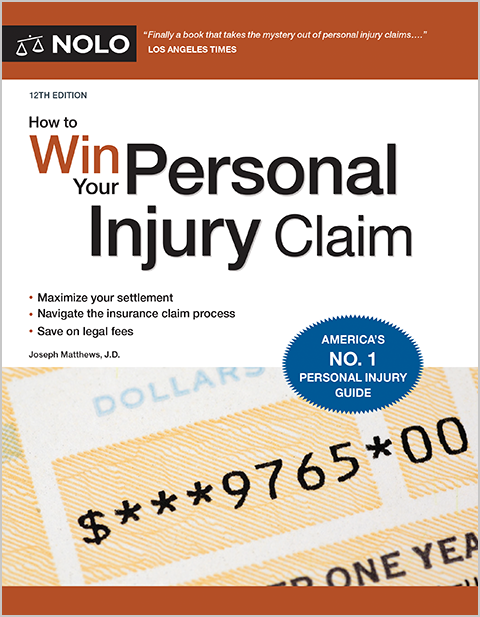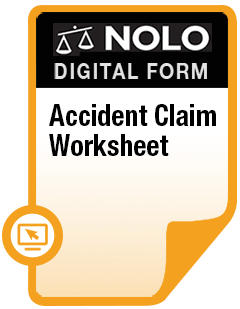Find out when you might be able to collect personal injury damages, in addition to workers' compensation benefits, for your workplace injury.
If you've suffered a workplace injury, you might think—or maybe you were told told—that the only payment you can get is from your employer's workers' compensation insurance. That's the general rule, but there's much more to it.
Depending on the circumstances, you might be able to file a lawsuit for personal injury damages, in lieu of or in addition to a workers' comp claim. In particular, you should be on the lookout for a possible personal injury claim when:
- your employer doesn't have workers' compensation insurance
- you were intentionally injured, or
- your injuries were caused by the wrongful conduct of a third party—someone other than your employer.
In the first two situations—no insurance or an intentional injury—you can bring a claim against your employer. When a third party is responsible, you'll bring an injury claim directly against them. We explain below.
- No Workers' Compensation Insurance
- When You're Intentionally Injured
- Suing Others for Your Workplace Injury
- Injuries Caused by Dangerous Machinery, Tools, and Products
- Injuries Caused by Third Party Negligence
- Illness From Toxic or Harmful Chemicals or Substances
- Workers' Comp Claims vs. Lawsuits: Pros and Cons
- Next Steps After a Workplace Injury
No Workers' Compensation Insurance
State workers' compensation laws take a "carrot and stick" approach to employer liability (legal responsibility) for workplace injuries. The carrot? Employers are off the hook for work-related accidents and illnesses as long as they carry workers' compensation insurance.
Employers who don't have comp coverage face the stick: An ill or injured employee can sue the employer outside the workers' compensation system to recover damages. It's a powerful incentive, one that works pretty well to accomplish it's desired goal.
Forty-nine states plus the District of Columbia require that employers maintain workers' compensation insurance. The lone exception is Texas, where coverage is optional for private employers. But Texas still follows the general rule: Employers who don't insure remain financially liable for employee damages. According to the Texas Department of Insurance, in 2022, 83% of private Texas employers opted to carry comp coverage.
When You're Intentionally Injured
Generally speaking, workers' compensation is the exclusive remedy for injuries and illnesses that happen within the course of an employee's job duties. But in most states, that rule doesn't apply when the injuries result from an employer's intentional wrongdoing.
Proving that an injury was intentionally caused can be difficult. States tend to follow one of two standards:
- the specific intent standard, or
- the substantial certainty standard.
Specific intent standard. This rule, adopted in a minority of states, is exceptionally difficult to satisfy. To meet it, the employee must show that the employer:
- acted with an actual, subjective intent to cause the specific injury the employee suffered
- had a deliberate desire to inflict the employee's injury, or
- consciously sought to bring about the harm experienced by the employee.
Substantial certainty standard. This standard doesn't require a showing of actual, subjective intent to harm. Instead, it asks whether the employer knew or should have known that an action was substantially certain to result in the employee's death or injury.
Finally, note that most often, the employee must prove intentional injury by a preponderance of the evidence, meaning it's more likely true than untrue that the employer intended to cause harm. A handful of states have adopted the more demanding "clear and convincing evidence" threshold.
Suing Others for Your Workplace Injury
Most workplace injury lawsuits aren't against the employer. Instead, they involve claims against third parties for:
- injuries caused by defective machinery, tools, equipment, or products
- injuries caused by negligence, and
- illness resulting from toxic or harmful substances in the workplace.
Injuries Caused by Dangerous Machinery, Tools, and Products
Suppose you're injured at work by a malfunctioning machine or a hazardous product. The thing that hurt you was designed, built, and sold to your employer by another company. Because it involved a workplace accident, your injury is covered by workers' comp.
But what about the manufacturer of the dangerous machine? Can you sue that company for your injuries? Yes. These product liability lawsuits are quite common, in fact. As long as you don't work for the company that made the dangerous machinery, equipment, or other product, that company can't hide behind your employer's workers' compensation lawsuit immunity.
Here's an example. Thea works in a box-making factory. She operates a punch press that punches holes in boxes. One day, when Thea put her hand into the press to adjust a box, the foot pedal she used to stop the press got stuck, causing the press to crush three of her fingers. Thea can collect workers' compensation from her employer, and she also has a possible product liability case against the manufacturer of the defective press.
So, if you've been injured by a dangerous machine or some defective equipment in your workplace, you can pursue both comp benefits and personal injury damages. Consider talking to an attorney about coordinating your claims.
Injuries Caused by Third Party Negligence
Lots of workplace injuries happen when some third party negligently (carelessly) causes injuries. In addition to claiming workers' compensation benefits, you can bring a personal injury claim against the responsible third party. These are among the most common third-party negligence claims.
Auto Accidents
Imagine that Diana drives a company car to make sales calls on her clients. While en route to a client appointment, she was hit by Joe, who ran a red light. Joe was at fault in the accident and caused Diana's injuries. Because the wreck happened while Diana was doing her job, she can file a workers' compensation claim. In addition, she can bring an auto insurance claim (or file a lawsuit) against Joe.
Dangerous Property
Let's say Jeff is a delivery driver for Worldwide Delivery Systems. Early one winter evening while delivering a package, Jeff slipped and fell on an icy sidewalk outside a business. The fall broke Jeff's ankle and injured his back. In addition to his comp claim, Jeff has a possible premises liability claim against the owner of the sidewalk.
The Workers' Comp Insurer's Right to Recover
Continue with our example of delivery driver Jeff. Suppose he gets a settlement from the negligent property owner. Does he get to keep the settlement money? Probably not—at least not all of it, anyway. In nearly every state, a workers' compensation insurer has a subrogation interest or a lien against third party proceeds. Let's illustrate with some numbers.
Assume that Jeff's employer's comp insurer paid:
- $3,200 in medical and surgical expenses on his behalf
- $3,800 in temporary total disability benefits, and
- $4,000 in permanent partial disability benefits.
The carrier's total payments come to $11,000. Assume further that Jeff settled with the property owner's liability insurer for $36,000. Jeff's attorney is entitled to a 33% contingency fee plus $2,000 in case expenses. How much will Jeff collect?
The answer depends on the workers' compensation law in the state where Jeff lives and works, but the numbers probably look something like this:
- $36,000 (total recovery) - ($12,000 (33% attorney's fee) + $2,000 (case expenses)) = $22,000 - $11,000 (workers' comp subrogation or lien interest) = $11,000 net recovery to Jeff.
You'll want advice from experienced counsel in a situation like this. State subrogation and lien laws can be complex and difficult to follow, and an attorney might be able to negotiate a better deal with the workers' comp insurer.
Illness From Toxic or Harmful Chemicals or Substances
Sometimes chemicals and other substances found in and around the workplace can cause severe injuries and illnesses. Asbestos, benzene, chromium compounds, silica, and radium are frequent culprits. When a third party is responsible for the manufacture, sale, or placement of these toxic substances, a worker who becomes ill might pursue an injury claim against them.
Kinds of Toxic Injuries
Generally speaking, there are two kinds of toxic injuries:
- acute injuries (like chemical burns or poisonings) that become apparent immediately or very quickly, and
- latent injuries (such as silicosis or cancers) that might take years or even decades to appear.
Because of the time delay, latent injuries tend to be more difficult to prove than acute ones. But workers have been successful in lawsuits brought years after their exposure to toxic substances. In particular, workers who suffer from asbestosis or mesothelioma often succeed because of the well-established relationship between asbestos exposure and asbestosis and mesothelioma.
Expect the manufacturer or seller of a toxic substance to put up a fight over liability. They'll argue that the employer failed to take proper safety precautions, didn't provide adequate safety equipment, or otherwise fell short in its obligation to protect workers. To the extent they can shift some of the blame to your employer, it minimizes their financial exposure to you.
What If the Workplace Exposure Happened a Long Time Ago?
When years or decades pass between your exposure to harmful substances and a diagnosed illness, there's a chance you might face these additional legal issues. If so, don't try to go it alone. They're among the most difficult and confusing of all laws. You'll want help from an experienced lawyer.
- Causation. To collect personal injury damages, you must prove that your illness was caused by a workplace exposure, as opposed to other environmental exposures.
- Statute of limitations. Every state has a statute of limitations that limits your time to file a lawsuit in court. Miss the filing deadline and a court will have no choice but to dismiss your case, meaning you've lost the chance to recover damages.
Workers' Comp Claims vs. Lawsuits: Pros and Cons
As a rule, a workers' compensation claim offers a quicker avenue to money and benefits. But temporary disability and permanent disability payments are likely to be low. They won't compensate you for the full spectrum of damages you might win in a lawsuit, including compensation for your pain and suffering and punitive damages.
While lawsuits offer the prospect of a larger monetary recovery, that possibility comes with costs. First, if you're forced to file in court, expect to pay significantly more in case expenses. Second, lawsuits take time. From filing until the date your case gets to trial, expect a delay of 9 to 12 months, maybe more. If there's an appeal, add another 6 to 12 months to your wait.
Next Steps After a Workplace Injury
If the circumstances of your workplace injury might allow you to file a personal injury lawsuit—in lieu of or alongside a workers' compensation claim—it probably makes sense to discuss your situation with a lawyer. Among other things, you need to consider liability issues, like your own and your employer's share of the blame for your injuries. You'll also need to deal with repayment of amounts the workers' compensation insurer paid to you or on your behalf.
Experienced legal counsel are familiar with these and other issues that might turn up. When you're ready to move forward, here's how to find an attorney who's right for you.
- No Workers' Compensation Insurance
- When You're Intentionally Injured
- Suing Others for Your Workplace Injury
- Injuries Caused by Dangerous Machinery, Tools, and Products
- Injuries Caused by Third Party Negligence
- Illness From Toxic or Harmful Chemicals or Substances
- Workers' Comp Claims vs. Lawsuits: Pros and Cons
- Next Steps After a Workplace Injury


